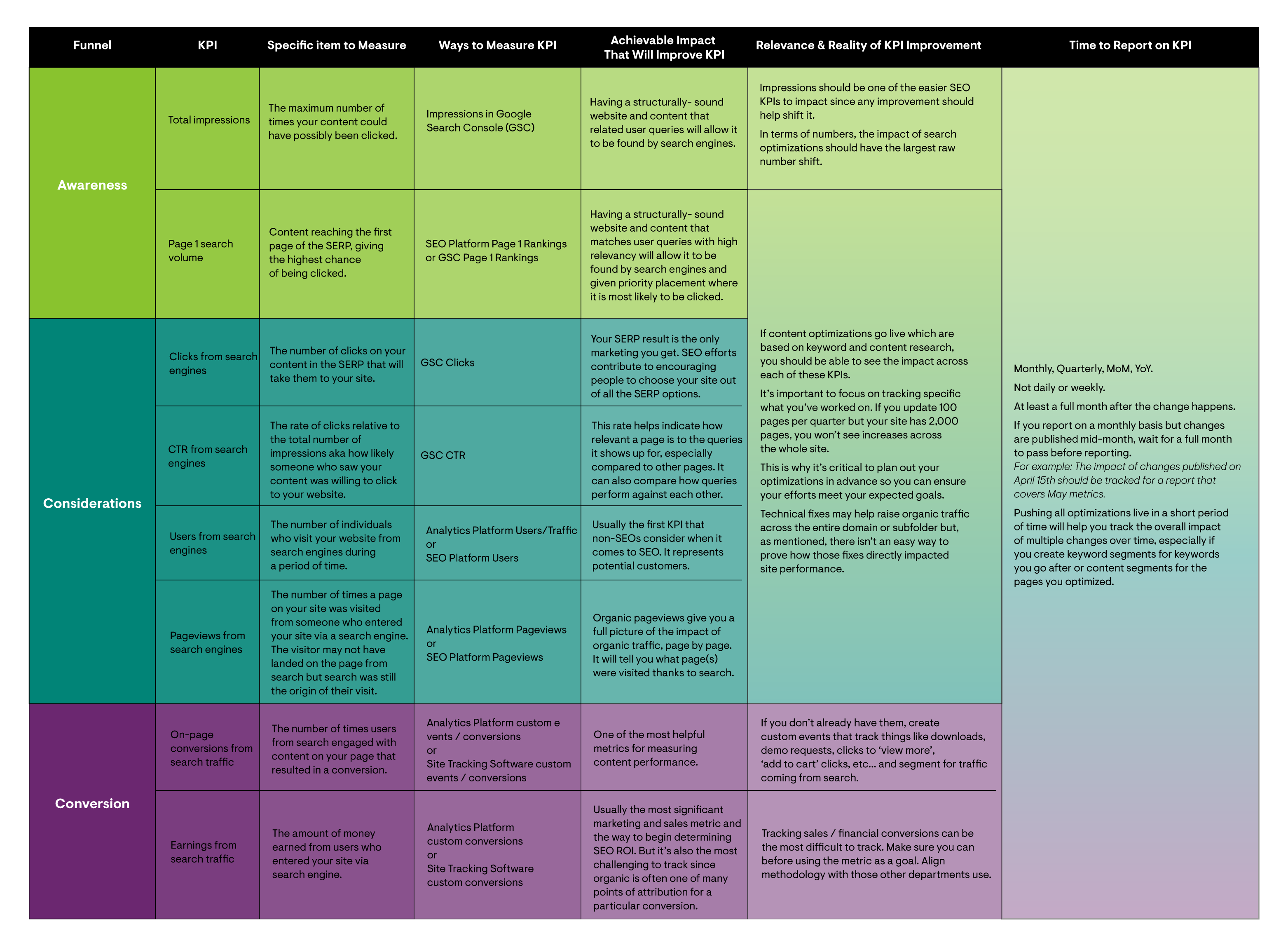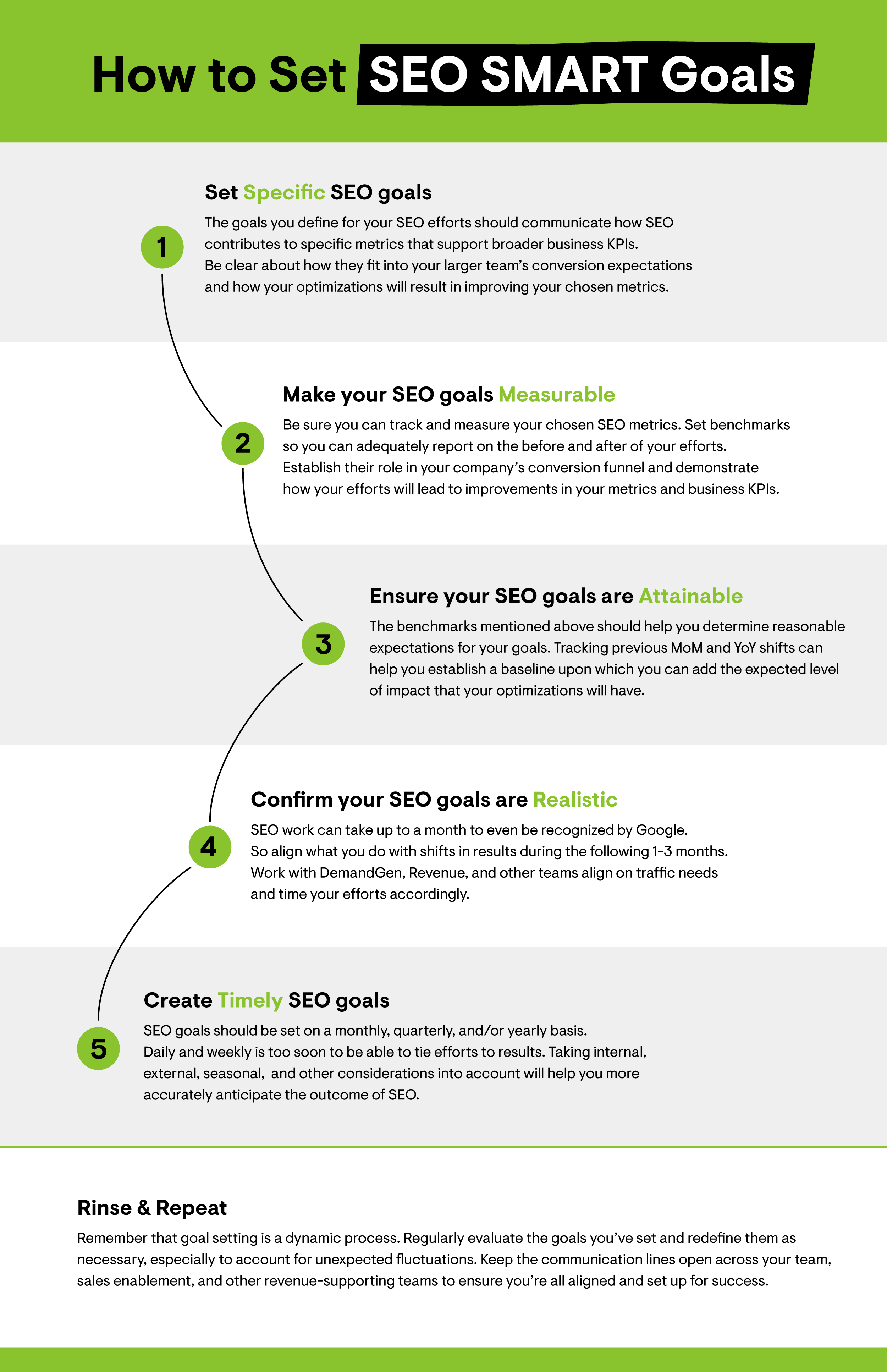A goal is only as useful as the thoughtfulness of creating it.
Like many overused marketing terms and cliches, a “goal” can become an overbearing or meaningless word or purposeless objective.
Employers may hand them down without fully understanding the feasibility of accomplishment. Employees may feel pressured to meet assigned goals, realistic or unrealistic, without a plan for how to reach them.
In particular, marketing leadership often overlook SEO goals if they assume organic is a cost-free acquisition channel that will automatically work for them behind the scenes.
Those who’ve worked in SEO for even a short time know that’s not how it works.
Especially in enterprise organizations.
While it can be challenging to determine the full impact of one’s SEO efforts, there are multiple KPIs and productive methods of tracking the effect of optimizations.
The most useful method of creating meaningful goals is applying the SMART framework to your KPIs.
You can apply the SMART framework to any goal, company, or business. But for SEO, there are particular considerations to include in your goal-building process.
And by layering SEO throughout this process, you’ll find goals that accurately reflect the impact of your SEO efforts and demonstrate you can deliver what you promised.
What Is A SMART Goal?
SMART stands for Specific, Measurable, Actionable, Realistic (or Relevant), and Timely (or Time-bound).
When creating any goal, ensure that those five dimensions apply to your goal.
As part of the goal-setting process, ask yourself each of these questions:
- What specifically is it that you plan to measure?
- Do you have a way to measure the KPI?
- Can you make an actionable impact on this KPI?
- Is the specific item you’re aiming to improve realistically changing based on your actions? Is it relevant to your company objectives?
- In what timeframe do you estimate showing your efforts’ impact on the KPI?
Go through these and only proceed to the next question if you can determine a reasonable answer to each.
Once you’ve answered each question, transform your findings into a definitive statement. And there you have it.
Applying The SMART Goals Process To SEO
The five principles of SMART can be applied to any business, company, or client.
But when creating SMART goals specifically for SEO, here’s how you should think about applying each to your goal-building process.
Specific
The purpose of SMART goals is to demonstrate the impact of specific marketing efforts, or in this case, your search and site optimizations.
Ultimately, you want to prove that your optimizations increased your business’ or client’s objectives and goals
Therefore, start the set-up of each SMART goal by choosing one particular KPI.
Limiting each goal to one KPI helps ensure the accuracy of the remaining four qualifications of SMART.
When picking a KPI for SEO, start by checking if you can tie your SEO KPIs into broader business goals and objectives.
That way, you can demonstrate how your search optimizations support your company or client’s marketing conversion funnel.
Within the funnel, these KPIs often start with total impressions on the SERP (Search Engine Results Page)and end with sales, purchases, or other financial transactions.
SEO KPIs Across The Marketing Funnel
Top Of Marketing Funnel (Awareness)
- Total impressions.
- Page 1 search volume.
- Clicks from search engines.
- CTR from search engines.
- Users from search.
- Pageviews from search.
- On-page conversions from search traffic.
- Earnings from search traffic.
Bottom Of Marketing Funnel (Conversion)
You may be inclined to rely on other SEO metrics such as specific results types, including Answer Boxes (also known as Featured Snippets), or People Also Ask placements.
However, there are two reasons to avoid those types of metrics.
They can drastically fluctuate in unrelated ways to your efforts, and more importantly, they don’t directly tie to the bigger picture business goals of traffic and conversions.
In contrast, Page 1 placements represent the number of times your content shows up on Page 1 of the SERP. There’s less than a 2.5% chance of a click if your content is not on Page 1.
So your presence on Page 1 is a huge indicator of the organic traffic you may be able to drive.
Similarly, conversions and earnings from search are particularly powerful KPIs to include in your goals as they help prove SEO and Content Marketing ROI, both critical determinants of marketing success.
Overall, it’s essential to ensure that our goals are crystal-clear and connected to our business objectives so everyone from the boardroom to the marketing department understands what success looks like.
Measurable
Fortunately, most SEO metrics are easy enough to track, as long as you have the right platforms, tools, and/or software set up to ingest your data:
- Website analytics, traffic, and acquisition sources can be tracked through tools such as Google Analytics, Adobe Analytics, or other tracking software.
- Search engines let you track your visibility, rank, and clicks of keywords that show your website through tools such as Google Search Console and Bing Webmaster Tools.
- Platforms such as BridgeEdge, Conductor, and Semrush capture your keyword rankings, rank changes, keyword MSV, result types, and so on for keywords you’ve tracked and those you research. Some have integrations that allow you to ingest your website’s data and crawl it.
- Site crawling can also happen with separate tools like ContentKing and DeepCrawl that track technical SEO components, such as title tags, meta descriptions, and alt tags, flag site errors, monitor Core Web Vitals like site speed, and more.
Before adding any of the metrics from these sources, you’ll need to establish a benchmark for it.
Timing and reporting will be discussed in greater detail when we get to the T in SMART, but essentially, your goal needs a comparison between two different points in time.
To compare data effectively, you’ll have to establish the baseline for the previous month, if not the year.
Unfortunately, it can be especially difficult to prove certain changes resulted in specific measurable metrics for SEO. And that needs to be expressed clearly when constructing and explaining your goals.
However, using segments to track specific pages you’ve updated and keywords for which you’re trying to optimize will help demonstrate whether results improved after your optimizations.
And by trying to ensure that you (or your content or web team) make your optimizations as close together as possible, you’ll have an easier time tracking changes over time.
Attainable And Achievable
There are many achievable and actionable ways to impact organic search performance.
SEO initiatives include keyword research, competitive analysis, site auditing, data analysis, resulting in optimization recommendations for new content, existing content, and technical fixes that improve the conversion funnel.
And hopefully, helps you beat out your competitors.
But not all SEO efforts can be tracked or clearly measured. Some challenges include not knowing the following:
- When Google crawls a new web page or recrawls an optimized one.
- When the SERP is updated to show optimized content.
- If the content is still relevant to consumers at that time to encourage clicks.
- If anything breaks on your site that causes errors or hurts rank or Core Web Vitals.
That last one represents why site health, internal/external linking, or other technical SEO metrics aren’t recommended for SMART Goals. There are just too many variables that you can’t control.
But by constructing your SMART Goals in a way that follows the conversion funnel, you can see the full picture that should more clearly highlight trends in organic success.
If any part of the funnel fluctuates unexpectedly, that may help flag external issues negatively impacting your success.
Plus, as long as you plan out your optimizations in advance, you can align your monthly goals to the level of impact you plan to have.
As long as you make those updates, you can get a sense of what you can achieve a month after each round of updates goes live.
Even if you don’t have SMART Goals for all parts of the funnel, tracking them will still help you better understand the role of organic at each stage and help you evolve your goals.
Realistic
Achievable also means realistic. Regardless of leadership expectations or the desire to set aggressive goals, you need to set reasonable expectations.
An up-and-coming company or one with very low SEO maturity may be able to set steep goals, at least initially, if they plan to implement improvements to the basic tenets and foundations of SEO.
A company already has a fairly high level of SEO maturity if they’ve optimized technical components, they are monitored frequently, and content is optimized regularly. It may only grow 7%–12% in metrics like organic traffic year over year.
So company context is key.
Before choosing specific metrics and estimating the improvement you’ll make, ask yourself:
- Can you realistically make headway on the keywords that you’re going after?
- Is there actual interest in the pages you’re trying to optimize?
- Will your optimizations actually go live?
- Do you have the resources to do the necessary SEO research and publish changes?
- Do you have the reporting set up to measure your KPI?
- Does the expected impact you intend to have on SEO match the SEO maturity level of the company or client you’re optimizing for?
Any one of these should be considered blockers when creating a SMART Goal.
Some versions of SMART use Relevant as the R.
But incorporating specific KPIs from within the conversion funnel that aligns with broader business objectives and goals – all of which are already built into this process – will ensure relevancy.
Time-bound And Timelined
Results should be demonstrable within an allotted time frame.
Establish a timeline with start and end dates to track when you expect to see your desired results based on when you begin your work.
This drives you to accomplish your goals in a set period and proactively manages leader and colleague expectations if someone asks you to speed up your efforts or asks why you haven’t achieved any of your goals sooner.
The actual optimizations you’ll want to measure, whether they are content or technical, can often be counted as soon as they go live, especially when SEO experts have direct access to edit their website.
But to adequately measure the impact of SEO efforts and prove effectiveness, either content or technical, you generally have to wait at least a month to begin measuring meaningful results.
Their impact could be visible as soon as the search engine crawls the page where the change happened.
But their impact needs at least a month to account for delays in crawling, for the change to reflect in the SERP, and for users to start engaging with content.
Especially if you have a site that is crawled less often, it may take Google an extended amount of time before it recrawls your site, allowing it to recognize the change.
Considerations Of SEO SMART Goals
Once you have considered all five of these components, carefully consider how they apply to the work you do regularly.
If you don’t find that your projects allow you to establish such goals, then perhaps it’s time to rethink your efforts or connect with your manager on expectations, available resources, and tracking options.
Framework For Creating SMART SEO Goals
To start building your own SMART goals for SEO, apply this process to each:
- Pick any of the KPIs. One at a time.
- Ensure that it aligns with broader business goals.
- Review all SMART concepts and confirm you can apply the principle to your work using the following matrix.
SEO SMART Goals Matrix
 View and download the framework here from Search Engine Journal
View and download the framework here from Search Engine JournalExamples Of SEO SMART Goals
Based on this framework, you might create SEO SMART goals such as:
- Move 20 optimized pages currently on Page 2 to Page 1 between 2022 Q2 and 2022 Q3.
- Increase clicks from Google by 6% MoM (May to June 2022).
- Increase organic traffic to your website by +10% by August 2022.
- Maintain a base of 20,000 organic visitors per week.
- Increase organic traffic to optimized pages by +16% within two months of the optimizations (July 2022).
- Increase organic downloads by 7% per page between new content published in ‘22 1H and new content published in 2022 2H.
- Increase revenue by 5% from organic sources for the next three months (June–Aug 2022).
Customizing Your SMART Goals For SEO
While you could adapt any of these goals to suit your SEO objectives and for any business, you’ll still have to consider the customizations needed.
When working on the R part of your SMART Goals, make sure you align the percentage increase with the extent of the effort you’ll be able to actualize.
Base the increases on original levels of impressions, organic users, and conversions per optimized page and total MSV and original placement of keywords.
If you have time, test out the impact of your optimizations for one or two months to determine the type of lift you see and aim to replicate that moving forward.
Regardless of customizations, ensure that your process follows the central tenants of SMART, as summarized in this infographic:
Challenges When Creating SEO SMART Goals
In some cases, you may need to broaden your goal to get it approved.
While you may not have a choice in the matter, inform leadership that the numbers you estimate are based on the impact you believe you will have on the pages and keywords you are optimizing for.
Certain technical improvements, structural and speed enhancements, and optimizations on components that impact more of the site (headers, footers, pages with multiple incoming and outgoing links, etc.) may help overall findability.
But they are fairly difficult to attribute to specific actions and are especially challenging to report on.
Stick to reporting on your more trackable efforts.
Conclusion
Building goals is a challenging process.
It’s a serious task that takes careful consideration, team collaboration, and, most notably, the ability to deliver what you proposed is necessary to reach the goals.
And just because you create a goal using the SMART process doesn’t mean you’ll always be able to meet it, let alone surpass it.
But the SMART framework – when applied conscientiously, accurately, and honestly – will ultimately help you help yourself.
It will support your ability to prove your value when implementing SEO and demonstrate how both you and your endeavors benefit your company and its goals.
Featured Image: Natee K Jindakum/Shutterstock






